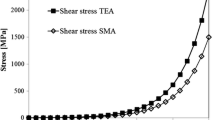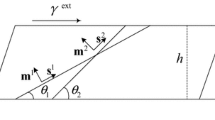Abstract
The effects of the capping-layer thickness and the discrepancy of the numbers of misfit dislocations at the upper and lower interfaces in capped layer on the excess stress are considered. Based on this, the formulae of excess stresses for single-and double-kink models are modified and a new formula is derived, which unifies single- and doublekink models and is valid for arbitrary capping-layer thickness. It is useful to complete the description of the formation and motion of misfit dislocations in strained layers.
Similar content being viewed by others
References
Van der Merwe, J. H., Crystal interfaces, Part II. Finite overgrowths,J. Appl. Phys., 1963, 34: 123.
Matthews, J. W., Blakeslee, A. E., Deffects in epitaxial multilayers,J. Cryst. Growth, 1974, 27: 118.
People, R., Bean, J. C., Calculation of critical layer thickness versus lattice mismatch for GexSi1−x/Si strained-layer het-erostructures,Appl. Phys. Lett., 1985, 47: 322.
Fritz, I. J., Gourley, P. L., Dawson, L. R., Critical layer thickness in In0.2 Ga0.8As/GaAs single strained quantum well structures,Appl. Phys. Lett., 1987, 51: 1004.
Gendry, M., Drouot, V., Hollinger, G. et al., Effect of surface steps and nonstoichiometry on critical thickness of strained InGaAs layers grown by molecular beam epitaxy on InAlAs/InP heterostructures,Appl. Phys. Lett., 1995, 66: 40.
Taguchi, T., Takeuchi, Y., Matugatani, K. et al. Critical layer thickness of 1n0.80 Ga0.20As/In0.52Al0.48 As heterostructures,J. Crystal. Growth, 1993, 134: 147.
Dodson, B. W., Tsao, J. Y., Relaxation of strained-layer semiconductor structures via plastic flow,Appl. Phys. Lett., 1987, 51: 1325.
Tsao, J. Y., Dodson, B. W., Picraux, S. T. et al., Critical stresses for SixGe1−x strained-layer plasticity,Phys. Rev. Lett., 1987, 59: 2455.
Tsao, J. Y., Dodson, B.W., Excess stress and the stability of strained heterostructures,Appl. Phys. Lett., 1988, 53: 848.
Dodson, B.W., Tsao, J. Y., Structural relaxation in metastable strained-layer semiconductors,Annu. Rev. Mater. Sci., 1989, 19: 419.
Houghton, D. C., Strain relaxation kinetics in Si1−xGex/Si heterostructures,J. Appl. Phys., 1991, 70: 2136.
Houghton, D. C., Misfit dislocation dynamica in Si1−xGex/(100)Si: uncapped alloy layers, buried strained layers, and multiple quantum wells,Appl. Phys. Lett., 1990, 57: 1434.
Houghton, D., Davies, M., Dion, M., Design criteria for structurally stable, highly strained multiple quantum well devices,Appl. Phys. Lett., 1994, 64: 505.
Hull, R., Bean, J., Thermal stability of Si/Gex,Si1−x/Si heterostructures,Appl. Phys. Lett., 1989, 55: 1900.
Hirth, J. P., Lothe, J.,Theory of Dislocations, New York: McGraw-Hill, 1985.
Author information
Authors and Affiliations
Additional information
Project supported by the National Natural Science Foundation of China (Grant Nos. 69896260 and 69676021).
Rights and permissions
About this article
Cite this article
Jin, Z., Yang, S., Ma, C. et al. Effect of non-strained capping layer on excess stress in strained layers. Sci. China Ser. A-Math. 42, 523–527 (1999). https://doi.org/10.1007/BF02882248
Received:
Issue Date:
DOI: https://doi.org/10.1007/BF02882248




